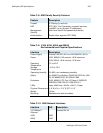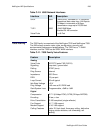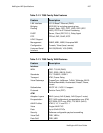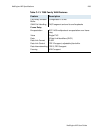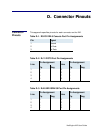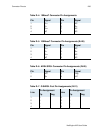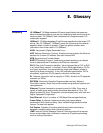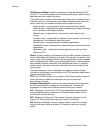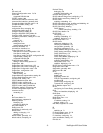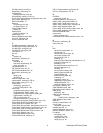
NetEngine IAD User Guide
Glossary 10/100BaseT. 10-Mbps baseband Ethernet specification that uses two
pairs of twisted-pair cabling: one pair for transmitting data and the other for
receiving data. 10/100BaseT has a distance limit of approximately 100
meters per segment.
100BaseT. 100-Mbps baseband Fast Ethernet specification that uses UTP
wiring. Like 10/100BaseT, 100BaseT sends link pulses over the network
segment when no traffic is present. These link pulses contain more
information than those used in 10/100BaseT.
ADSL. Asymmetric Digital Subscriber Line.
ARP. Address Resolution Protocol. Enables routers to obtain the Ethernet
address for a known IP address. See also Inverse ARP.
ATM. Asynchronous Transfer Mode.
BOOTP. Bootstrap Protocol. Used during network booting by a network
node to determine the IP address of its Ethernet interfaces.
DLCI. Data-Link Connection Identifier. Value that specifies a PVC or SVC
in a Frame Relay network. In the basic Frame Relay specification, DLCIs
are locally significant (connected devices might use different values to
specify the same connection). In the LMI extended specification, DLCIs
are globally significant (DLCIs specify individual end devices).
E1. Network connection with a capacity of 2.048, divided into 32 separate
channels (or DS0s).
EEPROM. Electrically Erasable Programmable read only Memory.
Nonvolatile memory chips that can be erased using electrical signals and
reprogrammed.
Ethernet. Physical connection commonly used for LANs. Runs over a
variety of cable types and provides theoretical bandwidth of 10 or 100
Mbps. Invented by Xerox Corporation and developed jointly with Intel and
Digital Equipment Corporation.
Fast Ethernet. Any of a number of 100 Mbps Ethernet specifications.
Frame Relay. A network interface providing high-speed packet
transmission with minimum delay. Uses variable-length packets called
frames. Contrast with packet.
Full Duplex. Capable of handling simultaneous data transmission
between a sending station and a receiving station.
ICMP. Internet Control Message Protocol. Internet protocol that reports
errors and provides other information relevant to IP packet processing,
such as routing information.
E. Glossary



